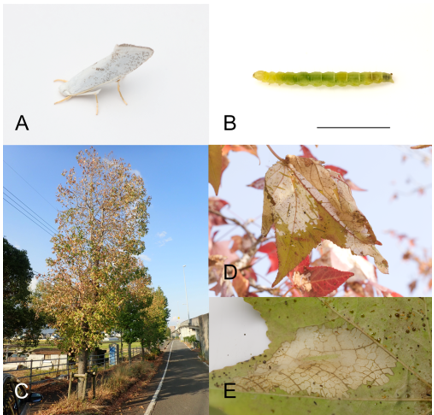Assistant Professor Sadahisa Yagi and his research team reveal the expanding presence of the invasive pest Thecobathra lambda in western Japan
-Possibility of multiple introductions and high parasitism rates by a parasitoid wasp newly recorded in Japan-
Points
- Liquidambar styraciflua is a tree species that is familiar to many as a common street and park tree in Japan. In 2017, it was first found to be infested by the invasive lepidopteran pest Thecobathra lambda in Kyushu, which causes severe feeding damage. However, subsequent research into its distribution, invasion pathways, and natural enemies has remained limited.
- A survey conducted at 17 locations across western Japan confirmed large-scale outbreaks of T. lambda in Hyogo, Tokushima, Kagawa, and Ehime Prefectures, and DNA sequence comparisons among populations suggested the possibility of multiple introductions or a large-scale invasion. Furthermore, five species of parasitoid wasps were identified, one of which, Diadegma armillatum, is a newly recorded species in Japan that exhibited exceptionally high parasitism rates, and DNA analysis of this wasp indicated that its distribution may have been artificially expanded between Europe and Japan.
- Diadegma armillatum has the potential to serve as a biological control agent (see note 1) against T. lambda; however, due to its broad host range, there are concerns about its potential impact on native moth communities and ecosystems. This highlights the need for continued, wide-ranging research to identify the invasion and dispersal routes of both the pest and the parasitoid, as well as to comprehensively assess their ecological effects on native biodiversity.
Abstract
In recent years, invasive insect species have caused serious damage to agriculture, forestry, and urban greenery across Japan. One such pest is the lepidopteran species Thecobathra lambda, which was first detected in Kyushu in 2017 and is known to cause extensive defoliation of Liquidambar styraciflua trees, which are a tree commonly planted in streets and parks. However, little research has been conducted on its establishment status, invasion pathways, and natural enemies since its initial invasion.
The research team comprised: Assistant Professor Sadahisa Yagi of Kyushu University; Dr. Kota Sakagami from the Museum of Nature and Human Activities, Hyogo; Curator Shunsuke Tomura from the Tokushima Prefectural Museum; and Dr. So Shimizu from the National Agriculture and Food Research Organization, conducted a survey at 17 locations across western Japan to investigate the distribution of T. lambda. The study confirmed large-scale outbreaks in Hyogo, Tokushima, Kagawa, and Ehime Prefectures, as well as the first recorded damage in Japan to L. formosana, a close relative of L. styraciflua. DNA sequence comparisons among populations suggested the possibility of multiple or large-scale introductions. In addition, rearing experiments identified five species of parasitoid wasps as natural enemies of the pest. Among them, Diadegma armillatum, newly recorded in Japan, was found to parasitize nearly half of the pest individuals, making it the most promising biological control agent. DNA analysis of D. armillatum further suggested that its distribution may have been expanded between Europe and Japan through human activities.
This study suggests the potential use of D. armillatum, the most promising natural enemy, as a biological control agent against T. lambda. However, due to its broad host range, careful evaluation is needed to assess its potential impacts on native ecosystems, including other moth species. The findings also highlight the importance of continued and large-scale research to clarify the origins and dispersal routes of both the pest and its parasitoid wasps.
This research was published in the international journal Applied Entomology and Zoology, issued by the Japanese Society of Applied Entomology and Zoology, at 10:00 AM JST on Friday, October 10, 2025.
Researcher's Comment

Thecobathra lambda (A, B) and the damage caused by its feeding activity (C-E)
Although Thecobathra lambda appears small, white, and charming at first glance, it is a serious pest capable of causing extensive damage-covering entire trees with white silk and, in severe cases, even leading to tree death.
Through our survey in western Japan, we discovered several unexpected and fascinating findings, such as the emergence of numerous parasitoid wasps and the presence of multiple haplotypes in this recently introduced invasive species.
In the near future, it is expected that this species will continue to expand its range, potentially causing damage in even wider areas. I encourage everyone to take a moment and look up at the Liquidambar trees near you.
- Sadahisa Yagi
Glossary
(Note 1): Biological Control Agent
In agriculture and forestry, a biological control agent refers to a natural enemy-such as a predator, parasitoid, or pathogen-used to suppress the occurrence of pests. It is considered an important component of pest management strategies that do not rely on chemical pesticides.
(Note 2): Haplotype
A haplotype is a genetic type determined by a specific combination of DNA sequences inherited from one parent.
Publication Information
Journal: Applied Entomology and Zoology
Title: Distribution range, genetic structure, and natural enemies of an invasive pest moth Thecobathra lambda (Lepidoptera: Yponomeutidae) damaging Liquidambar trees in Japan
Authors: Kota Sakagami, Shunsuke Tomura, Sadahisa Yagi, So Shimizu
DOI:10.1007/s13355-025-00932-w
- For more details on this research, click here.
For Research-related inquiries












 Contact
Contact
 Access Map
Access Map

